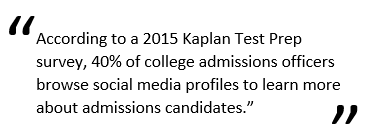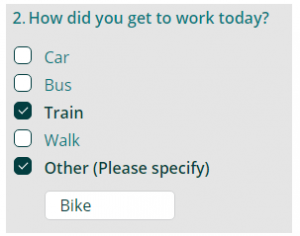Applying to college was one of the most stressful processes I’ve ever experienced. I’m sure applications have come a long way since, but I doubt that the stress on students has been alleviated.
Everyone faces the same application, so how do you provide honest, thoughtful answers while being insightful, articulate, and creative enough to differentiate yourself from all of the other hopeful candidates? It’s tough. And how do you make sure you’ve provided a fair representation of who you are – not just as a student, but a complete person with aspirations and goals. Just thinking about those essays gives me sweaty palms.
 It’s no surprise then that some of the most elite universities are stepping up their evaluation protocol for prospects – including a review of candidates’ online and social media behavior.
It’s no surprise then that some of the most elite universities are stepping up their evaluation protocol for prospects – including a review of candidates’ online and social media behavior.
When a student applies, she is saying “Yes, I want to be a part of your community and what it represents!” Admissions boards, in reviewing prospective students, must be sure that those they select have the scholastic merits and characteristics that align with the university’s cultural values.
Case in point: When Harvard University discovered that a few incoming freshmen had used a private group chat to share racist and other offensive memes, they revoked their admissions offers. While the students may have been upset, the university has this right. Simply put: when the admissions board uncovered this additional information, the picture revealed was not pretty, or in keeping with the university’s values. Call it a mistake or lapse in judgement on the part of the prospective students, but the full picture matters.
I can appreciate that trying to capture a complete understanding of an applicant is just as challenging for institutions as it is for students to describe themselves in 500 words or less. Getting the information you need from a candidate means asking thorough questions and providing complete answer options.
This might seem like an extreme case, but the truth is that incomplete data can change the picture entirely. Ensuring you get all the information you need starts with asking the right questions and offering the right answer options.
The Impact of Incomplete Answer Options
If you’ve got the right question in place, perfect, but that’s only half of what you need. If your survey doesn’t include all of the right possible answer options, your participants may feel confused or frustrated. Plus, if you force them to choose answers that aren’t true, you’re ending up with bad data and an inaccurate overall picture.
For example, let’s say that you got to work today by riding your bike to the train station and then taking the train the rest of the way. How would you answer this question?

In example A, a single-select question type, participants can only select one answer and part of your actual answer (bike) is not even an option. Frustrating and inaccurate.
Here’s an update:
Two improvements let participants answer accurately. First, this is now a multi-select question, and it also includes the option to specify an “Other” response that was not mentioned.
Sometime’s it’s okay to ask participants to make a decision, especially if you need to take action on the results. However, especially if it’s a mandatory question, you may need to include neutral options by either offering “Neither Agree nor Disagree” in the middle of a rating scale or giving them a “N/A” option at the end, in case the question does not apply.
How do you check for missing answer options or inaccurate question types? Fresh eyes can help. Ask a few colleagues or others to give feedback on a test link well before the survey launches. Testing your survey with a small group of participants can also be helpful.
The college admission process is not a perfect science and that’s part of what makes it challenging for administration and prospective applicants. To obtain a more complete view of a candidate, schools can take a page from survey best practices, like providing more complete answer options. And if you’re a high school student, just remember that your activity online is still a representation of who you are – put forward an image that would make any school of your choice honored to have you.







